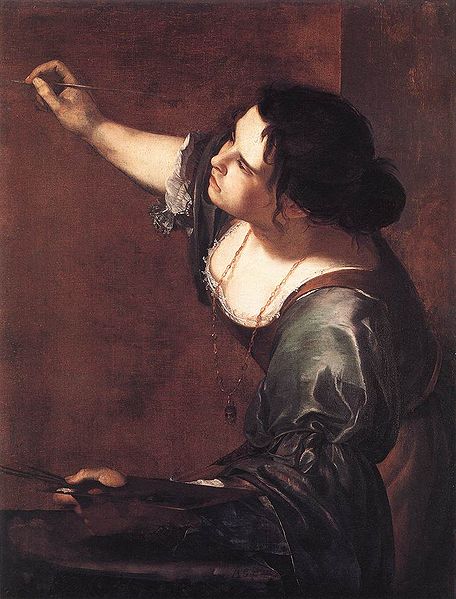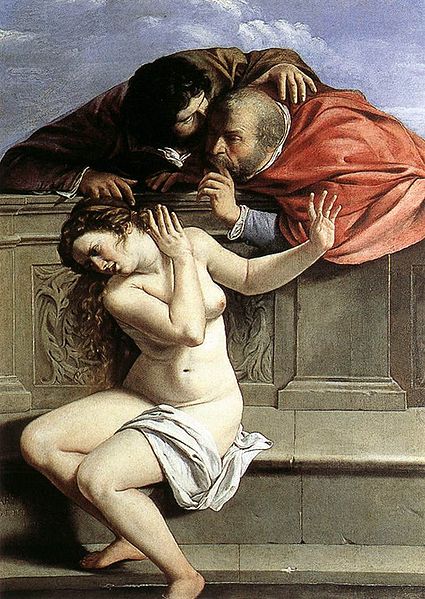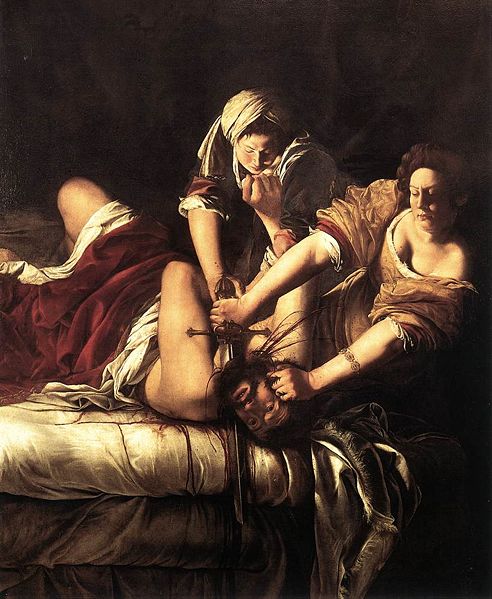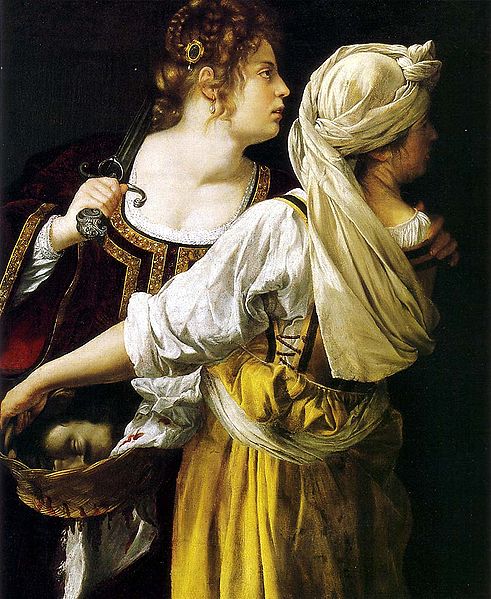<Back to Index>
- Archaeologist Sir Arthur John Evans, 1851
- Painter Artemisia Gentileschi, 1593
- Chief Minister of West Bengal Jyoti Basu, 1914

Artemisia Gentileschi (July 8, 1593 – ca. 1656) was an Italian Early Baroque painter, today considered one of the most accomplished painters in the generation influenced by Caravaggio. In an era when women painters were not easily accepted by the artistic community, she was the first female painter to become a member of the Accademia di Arte del Disegno in Florence. She was one of the first female artists to paint historical and religious paintings, at a time when such heroic themes were considered beyond a woman's reach.
Artemisia Gentileschi was born in Rome, July 8, 1593, the first child of the Tuscan painter Orazio Gentileschi.
Artemisia was introduced to painting in her father's workshop, showing
much more talent than her brothers, who worked alongside her. She
learned drawing, how to mix color and how to paint. Since her father's
style took inspiration from Caravaggio during that period, her style
was just as heavily influenced in turn. But her approach to subject
matter was different from her father's, as her paintings are highly
naturalistic, where Orazio's are idealized. The first work of the young 17-year-old Artemisia (even if many at the time suspected that she was helped by her father) was the Susanna e i Vecchioni (Susanna and the Elders) (1610, Schönborn collection in Pommersfelden). The picture shows how Artemisia assimilated the realism of Caravaggio without being indifferent to the language of the Bologna school (which had Annibale Carracci among its major artists). It is one of the few Susanna paintings showing the
two men planning their sexual harassment. It is likely that Artemisia
had been sexually harassed and painted Susanna as a reflection. In
1612, despite her early talent, Artemisia was denied access to the
all-male professional academies for art. At the time, her father was
working with Agostino Tassi to decorate the vaults of Casino della Rose inside the Pallavicini Rospigliosi Palace in
Rome, so Orazio hired the painter to tutor his daughter privately.
During this tutelage, Tassi raped Artemisia. Another man, Cosimo
Quorlis had helped Tassi with the rape. After the initial rape,
Artemisia continued to have sexual relations with Tassi, with the
expectation that they were going to be married. However, Tassi reneged
on his promise to marry Artemisia after he heard the rumor that she was
having an affair with another man. Quorlis had threatened that if he
could not have her, he would publicly humiliate her. Orazio pressed
charges against Tassi only after he learned that Artemisia and Tassi
were not going to be married. Orazio also claimed that Tassi stole a
painting of Judith from the Gentileschi household. The major issue of
this trial was the fact that Tassi had deflowered Artemisia. If
Artemisia had not been a virgin before Tassi raped her, the
Gentileschis would not be able to press charges. In
the ensuing 7-month trial, it was discovered that Tassi had planned to
murder his wife, had enjoined in adultery with his sister-in-law and
planned to steal some of Orazio’s paintings. During the trial,
Artemisia was given a gynecological examination and was tortured using
a device made of thongs wrapped around the fingers and tightened by
degrees. Both procedures were used to corroborate the truth of her
allegation, the torture device used due to the belief that if a person
can tell the same story under torture as without it, the story must be
true. At the end of the trial Tassi was imprisoned for one year. The
trial has subsequently influenced the feminist view of Artemisia Gentileschi during the late 20th century. The painting Giuditta che decapita Oloferne (Judith beheading Holofernes) (1612–1613), displayed in the Capodimonte Museum of Naples, is impressive for the violence portrayed. One month after the trial, in order to restore her honor, Orazio arranged for his daughter to marry Pierantonio Stiattesi, a modest artist from Florence. Shortly afterwards the couple moved to Florence, where Artemisia received a commission for a painting at Casa Buonarroti and became a successful court painter, enjoying the patronage of the Medici family and Charles I. It has been proposed that during this period Artemisia also painted the Madonna col Bambino (The Virgin and Child), currently in the Spada Gallery, Rome. While
in Florence, Artemisia and Pierantonio had four sons and one daughter.
But only the daughter, Prudenzia, survived to adulthood — following her
mother's return to Rome in 1621 and later move to Naples. After her mother's death, Prudenzia slipped into obscurity and little is known of her subsequent life. In Florence, Artemisia enjoyed huge success. She was the first woman accepted into the Accademia delle Arti del Disegno (Academy of the Arts of Drawing). She maintained good relations with the most respected artists of her time, such as Cristofano Allori, and was able to conquer the favours and the protection of influential people, starting with Granduke Cosimo II de' Medici and especially of the Granduchess Cristina. She had a good relationship with Galileo Galilei with
whom she remained in epistolary contact for a long time. She was
esteemed by Michelangelo Buonarroti the younger (nephew of the great Michelangelo): busy with construction of Casa Buonarroti to
celebrate his notable relative, he asked Artemisia to produce a
painting to decorate the ceiling of the gallery of paintings. The
painting represents an allegory of Allegoria dell' Inclinazione (Allegory
of the Inclination (natural talent)), presented under the form of a
young nude woman who holds a compass. It is believed that the subject
bears a resemblance to Artemisia. Indeed, in several of her paintings,
Artemisia's energetic heroines have a similar appearance to her
self-portraits. Her success and gender fueled many rumours about her
private life. Notable works from this period include La Conversione della Maddalena (The Conversion of the Magdalene), and Giuditta con la sua ancella (Judith and her Maidservant), now in the Pitti Palace. Artemisia painted a second version of Giuditta che decapita Oloferne (Judith beheading Holofernes), this one larger than the Naples version and now housed in the Uffizi Gallery of Florence. Despite
her success, due to an excess of expenses by her and her husband, the
Florentine period was full of problems with creditors and with her
husband. These problems led to her return to Rome in 1621. Artemisia arrived in Rome the
same year her father Orazio departed for Genoa. Some believe that
Artemisia followed her father there; while there is not enough evidence
for this, this time together would have accentuated the similarity of
their styles, which makes it often difficult today to determine which
of the two painted certain works. Most of the evidence supports the
notion that Artemisia remained in Rome,
trying to find a home and raise her daughters. In addition to Prudenzia
(born from the marriage with Pierantonio Stiattesi) she had another
natural daughter, probably born in 1627. Artemisia tried, with almost
no success, to teach them the art of painting. Caravaggio's
style, though the master had been dead over a decade, was still highly
influential and converted many painters to his style (the so-called Caravaggisti) such as Artemisia's father, Carlo Saraceni (who returned to Venice 1620), Bartolomeo Manfredi, and Simon Vouet.
However, painting styles in Rome during the early 17th century were
diverse, a more classic manner of the Bolognese disciples of the Carracci and the baroque style of Pietro da Cortona. It appears that Artemisia was also associated with the Academy of the Desiosi.
She was celebrated with a portrait carrying the incision "Pincturare
miraculum invidendum facilius quam imitandum". In the same period she
became friends with Cassiano dal Pozzo,
a humanist, collector and lover of arts. However, despite her artistic
reputation, her strong personality and her numerous good relationships,
Rome was not as lucrative as she hoped. The appreciation of her art was
narrowed down to portraits and to her ability with biblical heroines:
she received none of the lucrative commissions for altarpieces. The
absence of sufficient documentation makes it difficult to follow
Artemisia's movements in this period. It is certain that between 1627
and as late as 1630 she moved to Venice, perhaps in search of richer
commissions, as verses and letters were composed in appreciation of her
and her works in Venice. Although it is sometimes difficult to date her paintings, it is possible to assign to her these years the Ritratto di gonfaloniere (Portrait of Gonfaloniere), today in Bologna (a rare example of her capacity as portrait painter); the Giuditta con la sua ancella, (Judith and her Maidservant) today housed at the Detroit Institute of Arts. The Detroit painting is notable for her mastery of chiaroscuro and tenebrism (the effect of extreme lights and darks), techniques for which Gerrit van Honthorst, Trophime Bigot, and many others in Rome were famous. Her Venere Dormiente (The Sleeping Venus), today at Virginia Museum of Fine Arts, Richmond, and her Ester ed Assuero (Esther and Ahasuerus) located at the Metropolitan Museum of Art in New York, are testimony of her assimilation of the lessons of Venetian luminism. In 1630 Artemisia moved to Naples,
a city rich with workshops and art lovers, in search of new and more
lucrative job opportunities. Many other artists, including Caravaggio, Annibale Carracci, Simon Vouet had stayed in Naples for some time in their lives, and at that time, Jusepe de Ribera, Massimo Stanzione, and Domenichino were working there and later, Giovanni Lanfranco and many others would flock to the city. The Neapolitan debut of Artemisia is represented by the Annunciation in the Capodimonte Museum.
She remained in Naples for the remainder of her career with the
exception of a brief trip to London and some other journeys. Naples was
for Artemisia a kind of second homeland where she took care of her
family (both her daughters were married in Naples). She received
letters of appreciation, being in good relations with the viceroy the
Duke of Alcalá and started relations with many renowned artists,
among them Massimo Stanzione, with whom, the eighteenth-century writer Bernardo de' Dominici reports, she started an artistic collaboration based on a real friendship and artistic similarities. In Naples for the first time Artemisia started working on paintings in a cathedral, dedicated to San Gennaro nell' anfiteatro di Pozzuoli (Saint Januarius in the amphitheater of Pozzuoli) in Pozzuoli. During her first Neapolitan period she painted Nascita di San Giovanni Battista (Birth of Saint John the Baptist) located in the Museo del Prado in Madrid, and Corisca e il satiro (Corisca and the satyr),
in a private collection. In these paintings Artemisia again
demonstrates her ability to renew herself with the novelties of the
period and handle different subjects, instead of the usual Judith, Susanna, Bathsheba, and Penitent Magdalenes, for which she was already known. In 1638 Artemisia joined her father in London at the court of Charles I of England, where Orazio became court painter and received the important job of decorating a ceiling (allegory of Trionfo della pace e delle Arti (Triumph of the peace and the Arts) in the Casa delle Delizie of Queen Henrietta Maria of France in Greenwich.
Father and daughter were once again working together, although helping
her father was probably not her only reason for travelling to London:
Charles I had convoked her in his court, and it was not possible to
refuse. Charles I was a fanatical collector, willing to ruin public
finances to follow his artistic wishes. The fame of Artemisia probably
intrigued him, and it is not a coincidence that his collection included
a painting of great suggestion, the Autoritratto in veste di Pittura ("Self-Portrait as the Allegory of Painting."). Orazio
suddenly died in 1639. Artemisia had her own commissions to fulfill
after her father's death, although there are no known works assignable
with certainty to this period. It is known that Artemisia had already
left England by 1642, when the civil war was
just starting. Nothing much is known about her subsequent movements.
Historians know that in 1649 she was in Naples again, corresponding with Don Antonio Ruffo of Sicily who
became her mentor and good commitment during this second Neapolitan
period. The last known letter to her mentor is dated 1650 and makes
clear that she was still fully active. Artemisia was once thought to
have died in 1652/1653. Recent evidence, however, has shown that she
was still accepting commissions in 1654 — though increasingly dependent
on her assistant, Onofrio Palumbo. Thus it might be speculated that she
died in the devastating plague that swept Naples in 1656 and virtually
wiped out an entire generation of Neapolitan artists. Some works in this period are Susanna e i vecchioni (Susanna and the elders) today in Brno and Madonna e Bambino con rosario (Virgin and Child with a Rosary) today in El Escorial.


